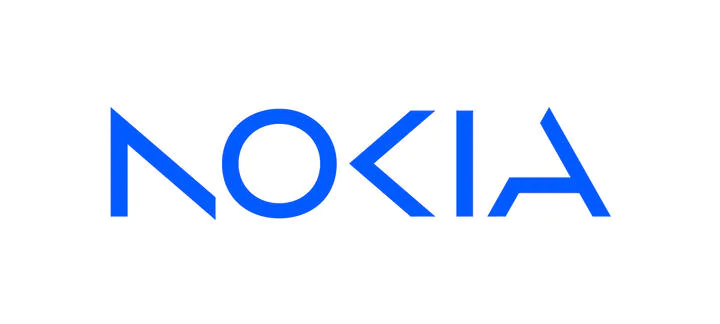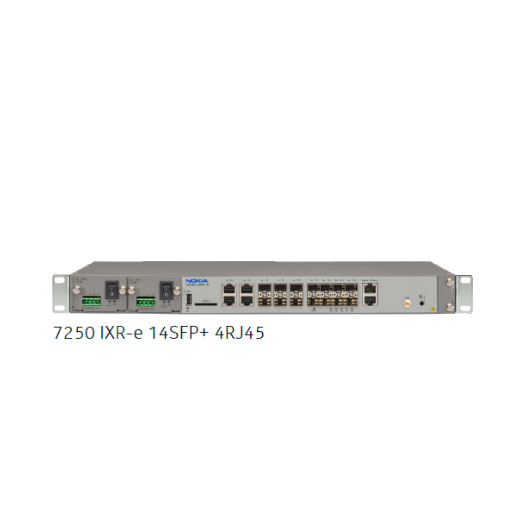Nokia 7250 IXR-e
14SFP+ 4RJ45
Interconnect Router
The 7250 IXR-e series features high system throughput and a variety of interfaces. 100GE ports used for high-speed uplinks enable costeffective 100GE ring architectures.
Nokia's Nokia 7250 IXR e 14SFP+ 4RJ45 Interconnect Router are used for access and aggregation and as 5G multi-access edge computing (MEC) leaf nodes. They are ideal for IP anyhaul and fixed-mobile convergence.
Nokia 7210 Procuct Family
The Nokia 7210 SAS product family provides service providers with IP routing and Carrier Ethernet demarcation, access, and aggregation for mobile backhaul, business, and residential service delivery. For enterprise and mission-critical network operators, the 7210 SAS addresses stringent requirements for high network resiliency, deterministic network performance, and scalability.
As a member of the Service Router (SR) product portfolio, the 7210 SAS leverages the proven Nokia Service Router Operating System (SR OS) and the Nokia Network Services Platform (NSP) for service and operational consistency across the network. The 7210 SAS is compliant with the Metro Ethernet Forum (MEF) Carrier Ethernet (CE) 3.0 specification, and with Hierarchical Quality of Service (H-QoS) and comprehensive operation, administration, and maintenance (OAM). The 7210 SAS provides deployment flexibility, service richness, and operational simplicity to extend IP/MPLS and Carrier Ethernet services throughout the network.
Features & Benefits
- 5G mobile and telco cloud infrastructures are moving toward 25GE interfaces. On the 7250 IXR-e series, the native 25GE ports are capable of supporting 10GE or 25GE transceivers. Combined with support for GE SFPs in all SFP+ cages, the 7250 IXR-e allows for seamless migrations from 1GE to 10GE to 25GE rates without the need to replace the router.
- The 7250 IXR-e’s compact (1RU) size and extended temperature range make it ideal for outside cabinet applications. It is ETSI 300-mm compliant, with all-up-front access and side-to-side air flow. A fan filter and redundant fans increase system lifetime and reduce maintenance costs. 7250 IXR-e systems consume approximately 20-25 percent less power than equivalent competing systems. Mass deployments for 5G will benefit significantly from this green design.
- The 7250 IXR-e series supports low-latency applications while providing a large buffer memory for delay-tolerant applications. Very granular per-service and per-forwarding class policing and queuing features support differentiated quality of service (QoS), making the 7250 IXR-e series ideal for any-G aggregation and fixed-mobile network convergence.
- The 7250 IXR-e’s compact (1RU) size and extended temperature range make it ideal for outside cabinet applications. It is ETSI 300-mm compliant, with all-up-front access and side-to-side air flow. A fan filter and redundant fans increase system lifetime and reduce maintenance costs. 7250 IXR-e systems consume approximately 20-25 percent less power than equivalent competing systems. Mass deployments for 5G will benefit significantly from this green design.
- To simplify and automate network operations, the 7250 IXR-e series enables model-driven network management features through the Nokia Service Router Operating System (SR OS) and is managed by the Nokia Network Services Platform (NSP), which offers a rich set of service management features that automate end-to-end service provisioning and operations, administration and maintenance (OAM) to enhance end-user experience and reduce operating costs. Standards-based software-defined networking (SDN) interfaces enable best-path computation to be offloaded to path computation elements (PCEs) such as the Nokia NSP. 7250 IXR-e-series routers operating as path computation clients (PCCs) collect and report per-link and per-service delay, jitter and loss metrics together with port utilization levels, for efficient path computation.
Ready for growth
Compact and power saving
Differentiated service support
Compact and power saving
Automation
Software Features
- Point-to-point Ethernet pseudowires/virtual leased line (VLL)
- Ethernet Virtual Private Network (EVPN)
- Virtual Private Wire Service (EVPN-VPWS)
- Virtual Private LAN Services (EVPN-VPLS): IPv4 and IPv6 support, including Virtual Router Redundancy Protocol (VRRP)
- Multihoming with single active or active/active modes
- Multipoint Ethernet VPN services with VPLS based on Targeted Label Distribution Protocol (T-LDP) and Border Gateway Protocol (BGP)
- Routed VPLS with Internet Enhances Services (IES)/IP-VPN IPv4 and IPv6
- Ingress and egress VLAN manipulation for L2 services IP VPN Virtual Private Routed Network (VPRN), Inter-Autonomous System (Inter-AS) Option A, B, and C
- IPv6 VPN Provider Edge (6VPE)
- Segment routing
- Intermediate System-to-Intermediate System (SR-ISIS) and Open Shortest Path First (SR-OSPF)
- Traffic engineering (SR-TE) IPv4, IPv6
- MPLS label edge router (LER) and label switching,router (LSR) functions
- LDP
- Resource Reservation Protocol with traffic engineering (RSVP-TE)
- BGP Labeled Unicast (LU) (RFC 3107) route tunnels
- IP routing
- Dual-stack Interior Gateway Protocol (IGP)
- Multi-topology, multi-instance IS-IS
- Multi-instance OSPF
- Multiprotocol BGP (MP-BGP)
- BGP-LU support in edge, area border router (ABR) and autonomous system boundary router (ASBR) roles
- Usage-triggered download of BGP label routes to Label - Forwarding Information Base (L-FIB)
- Accumulated IGP (AIGP) metric for BGP
- BGP monitoring protocol (BMP)
- BGP route-reflector for EVPN and IP-VPN with VPNv4 and VPNv6 address families (AFs)
- BGP confederations
- IGP and BGP shortcuts
- Layer 3 Multicast - base routing
- Internet Group Management Protocol (IGMP)
- Protocol Independent Multicast – Sparse Mode (PIM-SM), Source Specific Multicast (SSM)
- Multicast Listener Discovery (MLD)
- Layer 3 Multicast - VPRN
- Next-generation multicast VPNs (NG-MVPN)
- SSM with multicast LDPv4 (mLDPv4)
- IGMP/MLD
- IGMP/MLD on Routed VPLS Interface
- Layer 2 Multicast
- IGMP/MLD snooping
- SR-TE LSPs, RSVP-TE LSPs
- PCC initialized, PCC controlled
- PCC initialized, PCE computed
- PCC initialized, PCE controlled
- SR-TE LSPs: PCE initialized, PCE controlled
- Topology discovery: BGP-Link State (BGP-LS) IPv4 and IPv6
- Telemetry: streaming interface statistics, service delay and jitter metrics
- Netflow/cflowd
- Segment routing topology independent loop-free alternate (TI-LFA) and remote loop-free alternate (rLFA)
- LDP LFA and rLFA
- IEEE 802.3.ad Link Aggregation Group (LAG) and multi-chassis (MC) LAG
- Pseudowire and LSP redundancy
- IP and MPLS load balancing by equal-cost multipath (ECMP)
- Weighted LAG hash
- VRRP
- Ethernet Ring Protection Switching ITU-T G.8032v2
- Configurable polynomial and hash seed shift
- Entropy label (RFC 6790)RSVP-TE Fast Reroute (FRR)
- BGP Edge and Core Prefix Independent Convergence (BGP PIC)
- Ethernet IEEE 802.1Q (VLAN) and 802.1ad (QinQ) with 9K jumbo frames
- Detailed forwarded and discarded counters for service access points (SAPs) and network interfaces in addition to port-based statistics: per Virtual Output Queue (VoQ) packet and byte counters
- High-scale, per-policer, detailed counters on a per-state basis
- VLAN range-based SAPs
- Dynamic Host Configuration Protocol (DHCP server for IPv4 IES, VPNv4
- DHCP relay, IPv4 and IPV6, IES, IP-VPN, EVPN-VPLS
- Accounting records
- Hierarchical QoS (H-QoS)
- Hierarchical egress schedulers and shapersper forwarding class, SAP, network interface, port or LAG
- Port sub-rate
- Intelligent packet classification, including media access control (MAC), IPv4, IPv6 match-criteriabased classification
- Granular rate enforcement with up to 32 policers per SAP/VLAN, including broadcast, unicast, multicast and unknown policers
- Hierarchical policing for aggregate rate enforcement
- Strict priority, weighted fair queuing schedulers
- Congestion management via weighted random early discard (WRED)
- Egress marking or re-marking
- Simple Network Management Protocol(SNMP)
- Model-driven (MD) management interfaces
- NETCONF
- MD CLI
- Remote Procedure Call (gRPC)
- Comprehensive management with Nokia NSP
- Operations, administration and maintenance
- IEEE 802.1ag, ITU-T Y.1731: Ethernet Connectivity Fault Management (CFM) for both fault detection and performance monitoring, including delay, jitter and loss tests
- Ethernet bandwidth notification (ETH-BN) with egress rate adjustment
- IEEE 802.3ah: Ethernet in the First Mile(EFM)
- ITU-T Y.1564 Service Activation Test
- Bidirectional Forwarding Detection (BFD) IPv4, IPv6
- Micro-BFD - per member link
- Two-Way Active Measurement Protocol (TWAMP), TWAMP Light
- A full suite of MPLS OAM tools, including LSP and virtual circuit connectivity verification (VCCV) ping
- Service assurance agent
- Mirroring with slicing support
- Port
- VLAN
- Filter output: MAC, IPv4/IPv6 filters
- Local/remote
- Port and VLAN loopback with MAC-swap
- Configuration rollback
- Zero Touch Provisioning (ZTP) capable
- Remote Authentication Dial-In User Service (RADIUS), Terminal Access Controller Access Control System Plus (TACACS+), and comprehensive control-plane protection capabilities
- MAC-, IPv4- and IPv6-based access control lists and criteria-based classifiers
- Secure Shell (SSH)
- MACsec (7250 IXR-e small)
Each product model supports, but is not limited to, a variation of the following features. Please refer to 7210 SAS technical documentation for the features supported on each product
Services
Network protocols
SDN
Load balancing and resiliency
Platform
QoS and traffic management
System management
Security







